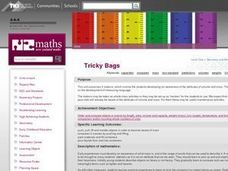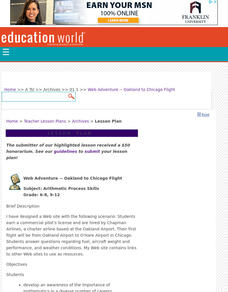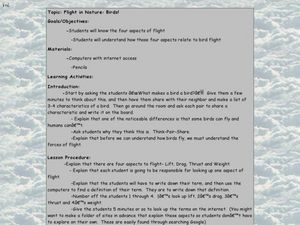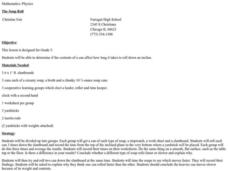Curated OER
Pumpkins By the Pound
Use pumpkins of various sizes to experiment with weight and perimeter. First the class lifts the pumpkins one by one, estimating each pumpkin's weight. They arrange the pumpkins from lightest to heaviest, and then string weigh each one...
Curated OER
Rescue Mission Game
Students conduct probability experiments. In this rescue mission lesson plan, sudents play a game and collect statistical data. They organize and interpret the data and determine the probability of success. Students plot points on a...
Teach Engineering
Balsa Glider Competition
Change one variable and try again. Teams build basic balsa gliders and collect data on their flight distances and times. Through collaboration, the team decides on two modifications to make to the basic design and collect data for the...
Curated OER
TRB 3:4 - Investigation 2 - Jump
Third graders jump with and without weights to reveal data that gravity has more of a pulling force with heavy objects that are on the ground than light objects on the ground. They also identify how their legs felt when they jumped with...
Curated OER
TE Activity: Pulley'ing Your Own Weight
Students experiment with common objects such as spools, string and soap to determine how pulleys make it easier to move large objects. They look at the difference between fixed and movable pulleys. They examine the many uses engineers...
Curated OER
Volume and Mass: Identify the Attribute
Students rotate through five studying stations related to the attributes of volume and mass. They manipulate objects to explore mass, compare two masses by pushing and lifting, pack materials and fill containers, and pour liquids from...
Curated OER
Math: Will The Airplane Get Off the Ground?
Students use data from real-life models to calculate and compare the force required for an airplane of a given weight to become airborne. They use a graphing calculator to evaluate data and use the World Wide Web to access data.
Curated OER
Pounds
In this mathematics worksheet, 1st graders identify which items pictured weighs more or less than a pound. Then they circle the objects that weigh more and place an X on the object that weigh less than a pound.
Curated OER
Wing Shapes and Areas
Students, after reading the explanation given below, use FoilSim to determine the weight of the aircraft that can be lifted by a pair of wings of each type. They also design a unique platform of a wing to lift a plane weighing 11500 pounds.
Curated OER
THE TRAVELS OF BABAR: An Adventure in Scale :Building a Model Hot Air Balloon
Young scholars encounter basic facts about helium and hot air. They compare the weight and size of different materials. Students work collaboratively in teams. They create their own model balloon.
Curated OER
Mathematics Module
Delve into graphing! The concepts covered begin with basic graphing basic coordinates and algebraic expressions on coordinate planes, and build up to graphing linear inequalities and equations. Learners solve and simplify various...
Perkins School for the Blind
More or Less
The concept of more or less is one that needs to be mastered prior to learning other concepts such as quantitative analysis, addition, or subtraction. This activity provides several ways to teach learners with low or no vision to...
Curated OER
Web Adventure -- Oakland to Chicago Flight
Students develop an awareness of mathematics in a diverse number of careers, then describe three duties of a pilot that require mathematical skills. They increase understanding of interpreting data relationships presented in table format.
Curated OER
Paper Dart Airplane
Students create a paper dart airplane and measure its flight pattern. In this flight lesson, students follow the included directions to build their own paper airplane. The students change the aileron configurations to see how it affects...
Curated OER
Experiments with Levers
Students investigate levers. In this simple machine lesson, students study levers and the mechanical advantage of using levers. They will collect data and illustrate their systems for eight different tests.
Curated OER
Flight in Nature: Birds!
Learners discover how flight works by researching birds. In this animal life lesson, students utilize the Internet to find information about the four aspects of flight. Learners define the four aspects and label a worksheet based on...
Curated OER
The Soup Roll
Fifth graders roll different sized cans down an inclined ramp in order to determine if the contents of a can affect the speed at which is rolls. In this physics lesson, 5th graders work in small groups to send each can down the ramp...
Curated OER
Does Shape Affect Drag?
Students study drag and how it affects a parachute in the sky. In this parachutes lesson students build models and compare their drag.
Curated OER
Designing Kites
Sixth graders sketch their own kites by creating a scale drawing of an original design. In this designing kites lesson, 6th graders draw a rough sketch, then accurately draw their design on large paper with a ruler, measuring precisely...
Curated OER
Altitude and Flight Forces
Learners use the World Wide Web to access and use FoilSim. They also use the World Wide Web to access the NASA Glenn Web site for information relative to the factors involved with the flight of an airplane.
Other popular searches
- Weight Lifting Program
- Weight Lifting Bench Press
- Fitness Weight Lifting
- Pe Weight Lifting
- Weight Lifting Unit
- Weight Lifting Unit Plans
- Weight Lifting Safety
- Weight Lifting and Training
- Pe, Weight Lifting
- Weight Lifting Lesson Plans
- Fitness + Weight Lifting





















